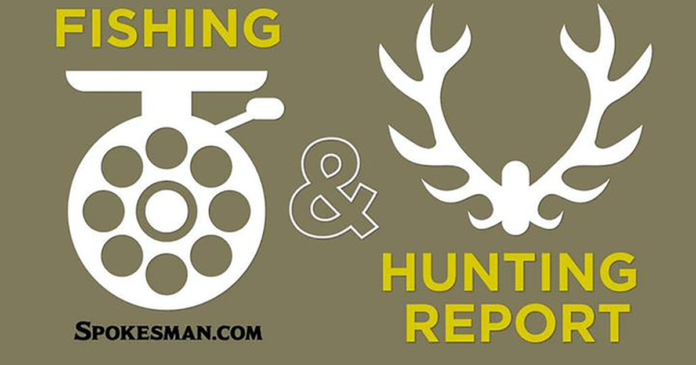Fly fishing
All local rivers are fishing well. There is a little more water in the Spokane River as the annual draw down of Lake Coeur d’Alene has begun. There are relatively low, easy flows for wading. Dry fly fishing has been good, as is nymphing/Euro fishing.
Some October caddis have been out in the afternoon/evenings on the North Fork Coeur d’Alene. Pack mahoganies, BWOs and midges. Riffles and any sort of faster water are getting less productive. Late morning into the late afternoon is good.
Fall fishing is always great on the St. Joe River. Pack your October caddis, mahogany duns, BWOs and midges. The smaller bugs play a more important role as weather cools.
Trout and kokanee
Clear Lake and Waitts Lake rainbows and browns have been feeding aggressively this month. While Clear closes at the end of October, Waitts remains open through the winter. Amber Lake (under selective gear rules) remains open through November with good numbers of rainbow and cutthroat trout. Medical Lake, another selective gear rule lake, is also open through November and has great opportunities for rainbow and brown trout.
Salmon and steelhead
The Clearwater and Grande Ronde rivers have been giving up a few steelhead, but runs are at an all-time low. The Idaho Fish and Game Commission reduced the bag limit for steelhead in sections of the Clearwater River to one fish per day and three in possession, which means all Idaho rivers open to steelhead harvest will have a bag limit of one fish per day and three in possession.
All waters of Drano Lake have returned to permanent rules as published in the fishing rules pamphlet. This rescinds the Sept. 4, fishing rule change that closed all angling in the northwest corner of the lake. Under permanent rules, fishing for or retaining steelhead remains closed through Oct. 31.
Spiny ray
October is a great time to catch a mess of perch. Look for them on the edges of weed beds in lakes like Spokane, Liberty, Eloika, Sacheen, Curlew, Banks, Moses , Potholes Reservoir, Fernan, Hauser, Cocolalla and Hayden. (Liberty Lake’s public access, incidentally, is closed to complete a construction project to improve it.) While perch are often difficult to find in Loon and Deer during the summer, the fall bite can be good for larger fish.
Hunting
If you hunt deer on this weekend’s opener in northeast Washington GMUs 105, 108, 111, 113, 117, 124 or 127, have your harvested whitetail tested for Chronic Wasting Disease (CWD) at one of WDFW’s check stations or other testing locations. The disease has not been detected in Washington to date but has been in 26 states – the closest being Montana – and also in four Canadian provinces. There is evidence that blue tongue and epizootic hemorrhagic disease are negatively impacting local whitetail populations in many Eastern Washington counties. On a short walk this week near my home north of Spokane, for example, I found four dead whitetail in or near adjacent ponds. A relative living near Addy reports similar findings.
The southeast district, made up of Asotin, Garfield, Columbia and Walla Walla counties, is best known for mule deer. GMUs with the highest success rates – 145, 149, 178 and 181 – also have the most private land so access can be limited.
GMUs 166 and 175 have the most public land but also the lowest success rates, in part due to high hunter numbers.
Okanogan County is prized for its mule deer hunting, although whitetails are also abundant, particularly in GMUs 204 and 215. The highest densities of mule deer can be found in the western two-thirds of Okanogan County. Whitetails, meanwhile, grow more abundant as you move east. Overall, total general season harvest and success rates are anticipated to be around the five-year average.
Douglas County is another good mule deer hunting area. Productivity remains consistent there, but it is dominated by private lands for which access permission must be secured. In Spokane, Lincoln and Whitman counties, there are almost equal hunting opportunities for whitetails and mule deer, although most of it is on private property. The best whitetail hunting is usually in GMUs 124 and 127. The best mule deer hunting is in GMUs 136, 139 and 142.
The Columbia Basin’s GMUs also produce good mule deer hunting opportunity, with most deer harvest in GMUs 272 (Beezley) and 284 (Ritzville). Hunters should expect an average year for mule deer hunting throughout Grant and Adams counties.
Duck (except scaup) and goose hunting in Washington opens Saturday, as does the deer season, but the best hunting in the region doesn’t kick in until late October or November. Grant County is consistently Washington’s top duck-harvest county. One of the more popular waterfowl hunting areas in the Columbia Basin district is Potholes Reservoir. Winchester Lake is another good spot but gets even more pressure. Three Regulated Access Areas in this district are also popular hunting destinations.
Mallards and Canada geese are the most often harvested waterfowl in Washington and Idaho. Canada geese are abundant throughout the season in the Pend Oreille, Colville, Kettle, Columbia, Spokane and Snake River valleys, especially in the bottom areas where there is extensive farmland.
Local waterfowl production in the Chelan district is up this year and hunters should have good opportunities in traditional areas and where permission to access ponds and lakes can be secured. Hunting along the Columbia River is usually consistent but dictated by local weather patterns.
The general season for pheasant hunting starts Oct. 23 in Eastern Washington, with most of the action in Whitman County and south of the Snake River. In addition to wild birds, pheasant hunting opportunities are enhanced with releases of farm-raised roosters at sites across the region. Details can be found at on the Eastern Washington Pheasant Enhancement Program web page.
Contact Alan Liere at spokesmanliere@yahoo.com
Credit: Source link






























